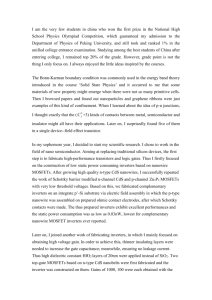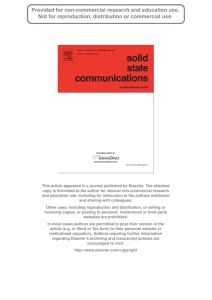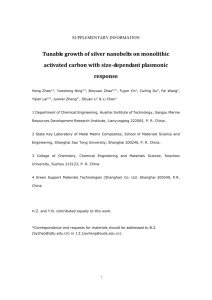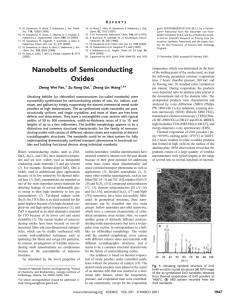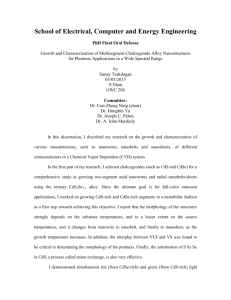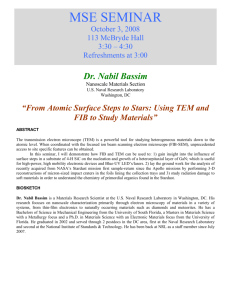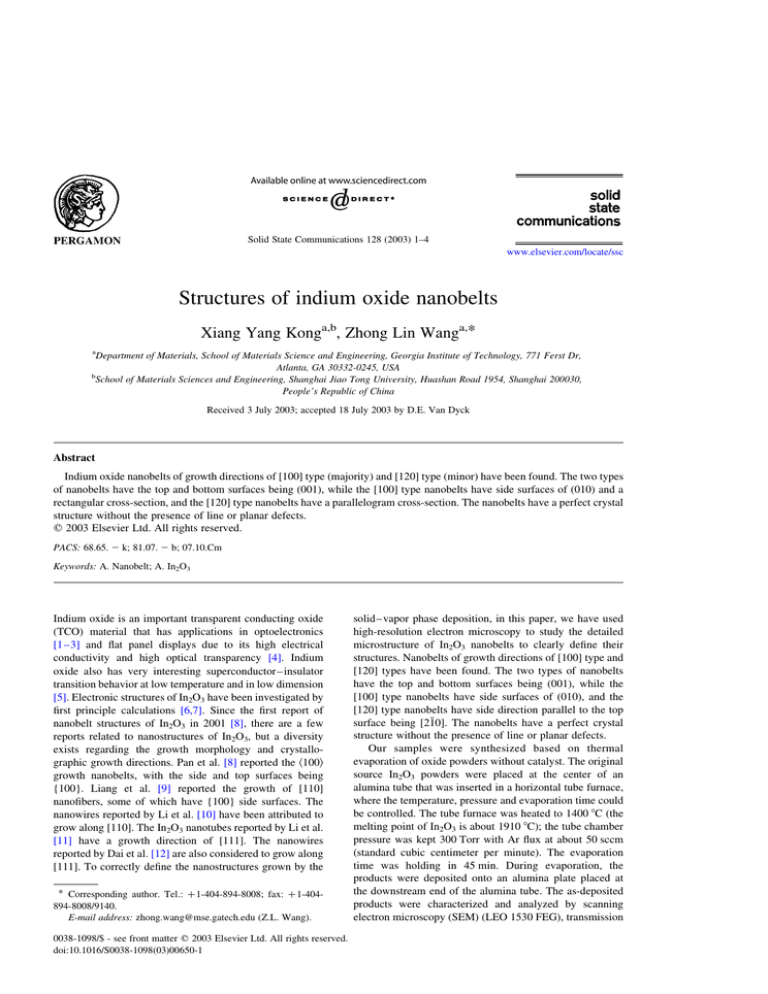
Solid State Communications 128 (2003) 1–4
www.elsevier.com/locate/ssc
Structures of indium oxide nanobelts
Xiang Yang Konga,b, Zhong Lin Wanga,*
a
Department of Materials, School of Materials Science and Engineering, Georgia Institute of Technology, 771 Ferst Dr,
Atlanta, GA 30332-0245, USA
b
School of Materials Sciences and Engineering, Shanghai Jiao Tong University, Huashan Road 1954, Shanghai 200030,
People’s Republic of China
Received 3 July 2003; accepted 18 July 2003 by D.E. Van Dyck
Abstract
Indium oxide nanobelts of growth directions of [100] type (majority) and [120] type (minor) have been found. The two types
of nanobelts have the top and bottom surfaces being (001), while the [100] type nanobelts have side surfaces of (010) and a
rectangular cross-section, and the [120] type nanobelts have a parallelogram cross-section. The nanobelts have a perfect crystal
structure without the presence of line or planar defects.
q 2003 Elsevier Ltd. All rights reserved.
PACS: 68.65. 2 k; 81.07. 2 b; 07.10.Cm
Keywords: A. Nanobelt; A. In2O3
Indium oxide is an important transparent conducting oxide
(TCO) material that has applications in optoelectronics
[1 –3] and flat panel displays due to its high electrical
conductivity and high optical transparency [4]. Indium
oxide also has very interesting superconductor – insulator
transition behavior at low temperature and in low dimension
[5]. Electronic structures of In2O3 have been investigated by
first principle calculations [6,7]. Since the first report of
nanobelt structures of In2O3 in 2001 [8], there are a few
reports related to nanostructures of In2O3, but a diversity
exists regarding the growth morphology and crystallographic growth directions. Pan et al. [8] reported the k100l
growth nanobelts, with the side and top surfaces being
{100}. Liang et al. [9] reported the growth of [110]
nanofibers, some of which have {100} side surfaces. The
nanowires reported by Li et al. [10] have been attributed to
grow along [110]. The In2O3 nanotubes reported by Li et al.
[11] have a growth direction of [111]. The nanowires
reported by Dai et al. [12] are also considered to grow along
[111]. To correctly define the nanostructures grown by the
* Corresponding author. Tel.: þ1-404-894-8008; fax: þ 1-404894-8008/9140.
E-mail address: zhong.wang@mse.gatech.edu (Z.L. Wang).
0038-1098/$ - see front matter q 2003 Elsevier Ltd. All rights reserved.
doi:10.1016/S0038-1098(03)00650-1
solid– vapor phase deposition, in this paper, we have used
high-resolution electron microscopy to study the detailed
microstructure of In2O3 nanobelts to clearly define their
structures. Nanobelts of growth directions of [100] type and
[120] types have been found. The two types of nanobelts
have the top and bottom surfaces being (001), while the
[100] type nanobelts have side surfaces of (010), and the
[120] type nanobelts have side direction parallel to the top
surface being [21̄0]. The nanobelts have a perfect crystal
structure without the presence of line or planar defects.
Our samples were synthesized based on thermal
evaporation of oxide powders without catalyst. The original
source In2O3 powders were placed at the center of an
alumina tube that was inserted in a horizontal tube furnace,
where the temperature, pressure and evaporation time could
be controlled. The tube furnace was heated to 1400 8C (the
melting point of In2O3 is about 1910 8C); the tube chamber
pressure was kept 300 Torr with Ar flux at about 50 sccm
(standard cubic centimeter per minute). The evaporation
time was holding in 45 min. During evaporation, the
products were deposited onto an alumina plate placed at
the downstream end of the alumina tube. The as-deposited
products were characterized and analyzed by scanning
electron microscopy (SEM) (LEO 1530 FEG), transmission
2
X.Y. Kong, Z.L. Wang / Solid State Communications 128 (2003) 1–4
Fig. 1. SEM images of In2O3 nanobelts, showing the uniform morphology and growth configuration.
electron microscopy (TEM) (Hitachi HF-2000 FEG at
200 kV and JEOL 4000EX high-resolution TEM (HRTEM)
at 400 kV), and energy dispersive X-ray spectroscopy
(EDS).
Fig. 1 shows SEM images of In2O3 nanobelts deposited
on an alumina substrate. The nanobelts are dispersively
distributed onto the substrate surface (Fig. 1a), and there
appears no correlation among the nanobelts and the
substrate. A higher magnification SEM image indicates
that the nanobelts have a fairly uniform size distribution,
with sizes of 20 – 40 nm in width and several microns in
length. All of the nanobelts are straight and structurally
uniform. It is also noticed that there is a triangular sheet in
the growth product, from the two corners of which two
nanobelts are grown along two perpendicular directions.
This type of structure is frequently observed. Such a
structure is clearly displayed by TEM image given in Fig.
2a. Electron diffraction from the structure unambiguously
indicates their single crystalline structure, and the two
nanobelts grow along [100] and [010], their top and bottom
surfaces are (001), and the side surfaces are (010) and (100),
respectively. The nanobelt has no line or planar defects,
while the contrast observed in the low-magnification image
is due to strain induced by bending. High-resolution TEM
image (Fig. 2b) clearly shows the perfect crystal structure of
the nanobelts, without line or planar defects. The highresolution TEM image also shows that there is no thickness
variation across the nanobelt. The profile image shown here
also presents a clean and atomically sharp and smooth {100}
surfaces. Therefore, the [100] type nanobelts have a
X.Y. Kong, Z.L. Wang / Solid State Communications 128 (2003) 1–4
Fig. 2. (a) Low-magnification TEM image and the corresponding
electron diffraction pattern from a ‘L’ shape nanobelt, oriented
along [001]. (b) High-resolution TEM image recorded near the side
surface of the nanobelt with electron beam parallel to [001]. The
flatness of the side surface can be clearly visualized from this profile
image. (c) A larger magnification of the TEM image, showing the
uniform contrast across the nanobelt.
rectangular cross-section. The [100] type nanobelts are the
dominant component of the growth product.
The other type of nanobelts found in the growth product
is the [120] type. Fig. 3a shows a low-magnification TEM
image of the nanobelt, and the corresponding highresolution TEM image is given in Fig. 3b, which displays
dislocation-free volume. A Fourier transform of the image is
given in Fig. 3c, which is indexed to be [001]. The most
interesting point is that the nanobelt grows along [120], and
its top and bottom surfaces are (001). The image contrast
further into the nanobelt is uniform, indicating a uniform
3
thickness of the nanobelt. The variation in contract within a
distance of , 5 nm from the edge of the nanobelt, however,
indicates a variation in the projected thickness along [001],
which suggests that the side facets of the nanobelt are not
parallel to the electron beam direction of [001], and thus the
(21̄0) plane may not be the side surface. We can confidently
conclude that the side direction of the nanobelt parallel to
the (001) top surface is [21̄0]. It is thus suggested that the
[120] type nanobelts have a parallelogram cross-section.
Structurally, In2O3 has the bixbyite structure (C-rare
earth crystal structure) as given in Fig. 4a, the space group
symmetry being Ia3 (206) and lattice constant being
1.0117 nm. Every unit cell contains eight formula units of
In2O3: indium atoms occupy Wyckoff positions 8b and 24d,
oxygen atoms occupy Wyckoff positions 48e. We have
found two types of nanobelts. The projection of the [100]
type nanobelt from [001] is given in Fig. 4b. Crystallographically, the (100), (010) and (001) are identical planes
with the same surface energy. Due to the unequilibrium
growth conditions, the anisotropic growth of the nanobelts
along one of the three identical axes is attributed to the
growth kinetics. The (100) surface is terminated with either
In or oxygen, thus, surface adsorption is expected to balance
the In terminated surface. Our TEM image shown in 2b
clearly indicates the atomic smoothness of the surface.
The [120] type nanobelt has the same (001) top surface,
and its structure model is given in Fig. 4c. There are cations
and anions on the side surface, which are distributed in a
zig– zag configuration along the surface, thus, the surface is
not likely to be atomically flat. This can be seen through the
profile TEM image given in Fig. 3b, where the zig – zag
atomic structures are visible toward the edge.
One of the important experience encountered in our
analysis is the correct observation of the nanobelts. If the
nanobelts lay down onto a flat carbon film without a
significant degree of tilting, the determined orientation
could be the true growth direction. On the other hand, the
nanobelt could lay onto the substrate at a small angle that is
closely to a zone axis, the electron diffraction determined
growth direction would not be the true growth direction but
the projected direction perpendicular to the beam. A
practical operation to avoid this mistake is to examine a
lot of more nanobelts using TEM before a structural
configuration is given. This is the reason that we believe
that there are diversity in the reported growth directions in
the literature.
In conclusion, the microstructures of In2O3 nanobelts
have been investigated by high-resolution electron
microscopy. Nanobelts of growth directions of [100] type
(majority) and [120] type (minor) have been found. The two
types of nanobelts have the top and bottom surfaces being
(001), while the [100] type nanobelts have side surfaces of
(010) (rectangular cross-section), and the [120] type
nanobelts have a side direction parallel to the top surface
being [21̄0] and an inclined side surface (parallelogram
cross-section). The nanobelts have a perfect crystal structure
4
X.Y. Kong, Z.L. Wang / Solid State Communications 128 (2003) 1–4
Fig. 3. (a) Low-magnification TEM image of a [120] type In2O3 nanobelt. (b) High-resolution TEM image recorded with the incident electron beam
parallel to [001]. (c) A Fourier transform of the image given in (b). (d) An enlarged TEM image showing the [001] projected structure of the nanobelt.
without the presence of line or planar defects. The surfaces
of the nanobelts are smooth and without much contamination. Using these structurally controlled nanobelts, a large
variety of interesting physical properties can be studied.
Acknowledgements
Research sponsored by NSF NIRT.
References
Fig. 4. (a) Unit cell of In2O3. (b) [001] Projected model of the [100]
type nanobelts. (c) [001] Projected model of the [120] type nanobelts.
[1] S. Ishibashi, Y. Higuchi, Y. Oa, K. Nakamura, J. Vac. Sci.
Technol. A 8 (1990) 1399.
[2] K.L. Chopara, S. Major, D.K. Pandya, Thin Solid Films 102
(1983) 1.
[3] J.L. Yao, S. Hao, J.S. Wilkinson, Thin Solid Films 189 (1990)
227.
[4] Z.M. Jarzebski, Phys. Status Solidi A 71 (1982) 13.
[5] V.F. Grantmakher, M.V. Golubkov, V.T. Dolgopolov, G.E.
Tsydynzhapov, A.A. Shashkin, JETP Lett. 68 (1998) 363.
[6] H. Odaka, S. Iwata, N. Taga, S. Ohnishi, Y. Kaneta, Y.
Shigesato, Jpn. J. Appl. Phys., Part 1 36 (1997) 5551.
[7] I. Tanaka, M. Mizuno, H. Adachi, Phys. Rev. B 56 (1997)
3536.
[8] Z.W. Pan, Z.R. Dai, Z.L. Wang, Science 291 (2001) 1947.
[9] C. Liang, G. Meng, Y. Lei, F. Phillipp, L. Zhang, Adv. Mater.
13 (2001) 1330.
[10] C. Li, D. Zhang, S. Han, X. Liu, T. Tang, C. Zhou, Adv. Mater.
15 (2003) 143.
[11] Y. Li, Y. Bando, D. Golberg, Adv. Mater. 15 (2003) 581.
[12] L. Dai, X.L. Chen, J.K. Jian, M. He, T. Zhou, B.Q. Hu, Appl.
Phys. A 75 (2002) 687.

